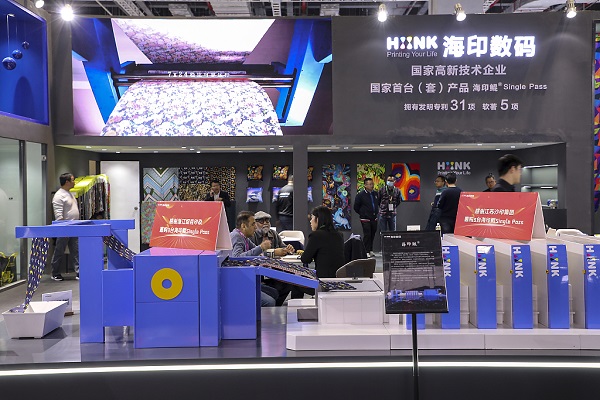digital fabric printing gaining popularity among textile players

the exhibition pavilion of hi-ink digital technology at an expo in shanghai, nov 21, 2023. [photo/vcg]
digital fabric printing is gaining a strong foothold in the yangtze river delta region, a hub for textile production and exports in china.
this new mode of printing, which uses inkjet technology to print on fabric or garments, has the advantage of etching colorful and complicated designs on fabric with high precision, reducing harm to the environment due to its "green" technologies.
digital fabric printing is appropriate for small-scale production, as it is more cost-effective and less demanding than screen printing techniques.
nevertheless, it is becoming popular in large-scale and mass-production fabric printing, as an alternative to rotary screen printing.
at a factory of hi-ink digital technology co ltd in zhejiang province, several large machines are running at high speed, efficiently printing patterns on fabrics through digital printing technology.
these machines belong to the "kun" series of single-pass digital printing equipment, which was first produced by the company.
founded in 2016, hi-ink digital technology is located in shaoxing, zhejiang, which is known as the "world cloth city".
the company first produced the "kun" series of single-pass digital printing equipment in 2019, reforming the traditional printing technology and increasing the competitiveness of china's digital printing technology in the international market.
china is the world's largest textile processing and exporting country, and the yangtze river delta area is its hub for both production and exports.
earlier, traditional printing and dyeing technology — which involved the costly process of making the screen and paste — used to lead to excessive wastage that harmed the environment.
after the advent of digital printing technologies, multipass printing was widely applied. however, its daily output could only reach 600 to 3,000 meters per set, much smaller than that of traditional machines, which can produce 20,000-60,000 meters per set.
in 2014, song shuiyou, founder of hi-ink digital technology, proposed a digital printing platform that had more advantages in terms of daily output and printing costs than traditional printing techniques.
after a number of experiments, the "kun" series of single-pass digital printing equipment was developed, overcoming previous disadvantages.
the "kun" single-pass digital printing machine's speed is 80 meters per minute and its daily output hits 60,000-100,000 meters per set, which is 1.5 times that of a traditional rotary screen printing machine, five times that of a flat screen printing machine, and 1.5-2 times that of similar foreign-made products.
furthermore, the machine also features higher printing quality, with a physical accuracy of up to 1200 dpix2400 dpi, which is four times that of the common multipass machine in the market.
since it does not involve making the screen and paste, the printing cost is greatly reduced, making it effective over traditional printing in mass production.
the single-pass digital printing machine has the potential to completely replace traditional printing machines, causing less waste and pollution.
according to a third-party testing report, the "kun" single-pass equipment can reduce electricity consumption by 52.02 percent, water by 46.66 percent, steam by 51.39 percent, and carbon dioxide emissions by 51.44 percent during the printing process, compared with traditional printing methods.
at present, a total of 21 sets of "kun" single-pass machines have been applied in china, accounting for more than 70 percent of all single-pass machines in the country.
in 2023, the company achieved a revenue of 140 million yuan ($19.63 million).
the emergence of the "kun" single-pass digital printing equipment has enabled the textile printing and garment industry to reverse the earlier model of basing sales on production, helping to solve the problem of overstocking and resource wastage, thereby realizing environmentally friendly and sustainable development of the industry.
with this, china's textile industry has entered a new era in three new aspects: science and technology, fashion, and green processes.
as a key link in the textile industry chain, printing and dyeing is an important process to enhance the added value of textiles.
in recent years, china has issued a series of industrial policies to encourage intelligent manufacturing equipment and green printing and dyeing, thus supporting the application of digital printing technology in the textile industry.
song said that in addition to the existing "kun" single-pass machine for fabric printing, the company is working on new product lines and exploring new application areas, including printing equipment for wide fabrics in home textiles and for book printing.
"we are now actively seeking to explore further international markets, such as india, pakistan and southeast asian countries, with more chinese textile manufacturers growing active in seeking to enhance their supply chain abroad," song said.
mazhenhuan@chinadaily.com.cn
-
'nice' to meet you, hangzhou
may 6, 2024

